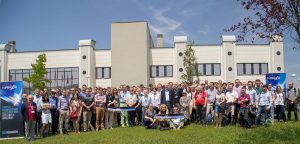 In 1589 the Italian scientist Galileo Galilei performed in Pisa his ground-breaking acceleration experiments, observing balls accelerating down a ramp. He timed the rolling balls by counting his heart beat, finding that the “the spaces traversed were to each other as the squares of the times”. Galileo’s results violated the ancient theory from Aristotles and a few years later Galieo’s contract as lecturer at Pisa University was not renewed. Nowadays school kids all over the world learn about acceleration with the famous formula from Galileo.
In 1589 the Italian scientist Galileo Galilei performed in Pisa his ground-breaking acceleration experiments, observing balls accelerating down a ramp. He timed the rolling balls by counting his heart beat, finding that the “the spaces traversed were to each other as the squares of the times”. Galileo’s results violated the ancient theory from Aristotles and a few years later Galieo’s contract as lecturer at Pisa University was not renewed. Nowadays school kids all over the world learn about acceleration with the famous formula from Galileo.
The future of acceleration, this time related to efficient acceleration of elementary particles, was again discussed last week in Pisa, Italy. Particle accelerator experts from around the world met together with experts from the laser and novel accelerator community to discuss the design of an innovative European Plasma Accelerator in the framework of the EuPRAXIA and EuroNNAc projects. This science workshop took place from June 29th to July 1st at Area della Ricerca in Pisa, Italy and was hosted by Istituto Nazionale di Ottica – CNR.
The design and science cases of novel plasma accelerators for beams of electrons are subject of intense studies. Progress in proof-of-principle experiments has led to the expectation that ground-breaking applications of plasma accelerators will be developed in the next years. The more than 120 registered delegates discussed the parameters and technical specifications required at the interfaces between lasers and plasmas, plasmas and particle beams, as well as particle beams and other applications such as Free Electron Lasers, High Energy Physics detectors and ultra-compact X ray devices. The aim was to collect the input from all interested parties in order to define a full parameter set that will be used as the core of a conceptual design that will be developed by the project partners until October 2019.
The Horizon2020 Project “European Plasma Research Accelerator with eXcellence In Applications” (EuPRAXIA) was funded by the European Union and started its work in November 2015. EuPRAXIA aims at producing a design report of a highly compact and cost-effective European facility with 5 GeV electron beams generated by plasma acceleration which could be used for photon science, high-energy physics, and other applications such as medicine or material processing.
The Frascati group plays a leading role in the EUPRAXIA Collaboration, represented by the operation of the SPARC_LAB infrastructure devoted to plasma acceleration R&D, and to THz and Compton radiation sources.
The meeting was sponsored by INO-CNR, INFN, the European Network for Novel Accelerators (FP7/EuroNNAc2), the European Coordination of Accelerator R&D project (FP7/EuCARD2) and the Horizon2020 Design Study EuPRAXIA.
All presentations and further information can be found on the workshop’s indico page. For more information about EuPRAXIA, please refer to the project website.
 INFN-LNF Laboratori Nazionali di Frascati
INFN-LNF Laboratori Nazionali di Frascati